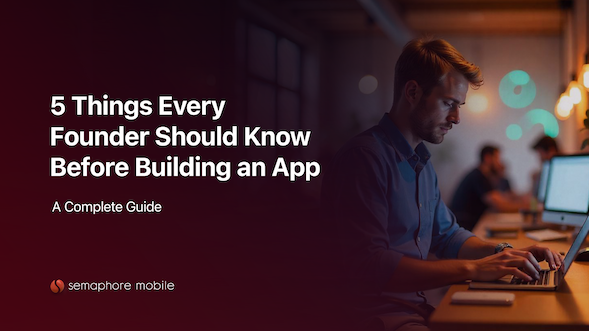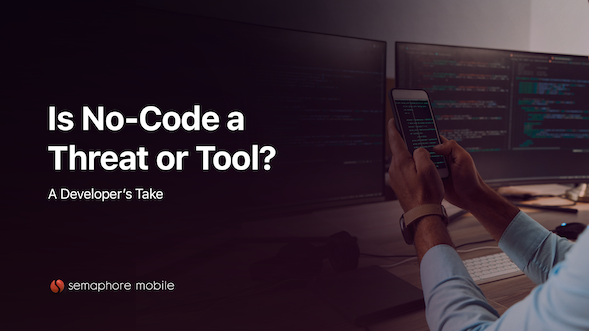
5 Things Every Founder Should Watch for When Building an App
Building an app is one of the most exciting steps a startup founder can take but it’s also one of the riskiest. It’s easy to get caught up in the thrill and lose sight of the critical strategy that ensures your product succeeds. Moving too quickly or skipping foundational steps often leads to wasted time, budget overruns, or apps that completely miss the mark.
This guide outlines five crucial lessons that can help you avoid the most common pitfalls in app development for startup founders.
At Semaphore, we partner with founders to help them move quickly, confidently, and clearly. We do more than just create apps. Our objective is to position you for long term success, from early validation to wise growth.
01. Stay Focused on the Problem, Not Just Your Idea
Talk to Users Before You Write Code
Founders are extremely passionate about their product ideas. Although that passion is necessary, it can also work against you if it causes you to lose sight of reality. The harsh truth is that no one cares about your idea unless it solves a real, painful problem for them.
The most successful products are built around user pain, not founder imagination. This is why talking to users before writing a single line of code is critical. Conduct interviews, ask probing questions, and learn how people currently solve or struggle with the problem you aim to address. If you’re not hearing frustration, urgency, or existing hacks to solve the problem, you may not have found a true pain point yet.
Think of it this way, people pay for painkillers, not vitamins. A cool app that solves a low priority inconvenience won’t gain traction. One that alleviates daily friction will.
Red Flags to Watch For
If you’re brushing aside tough feedback, rephrasing negative insights to fit your narrative, or over relying on your own assumptions, you’re on dangerous ground. Another red flag is building before validating. A strong product foundation starts with humility and deep listening.
Falling in love with your solution too early can be fatal. Real innovation doesn’t start with features, it starts with empathy. The earlier you talk to users, the more clarity you’ll gain around what actually needs to be built.
02. Don’t Let Your MVP Become a Mini Full App
Your MVP Is About Learning, Not Launching All the Features
The MVP minimum viable product is often misunderstood. Founders hear “product” and imagine a polished, scalable solution with all their top features packed in. But that’s not what an MVP is about. A real MVP is a learning tool, a fast, low-cost way to validate whether your riskiest assumption is correct.
It’s not about building “something small.” It’s about building only what’s necessary to answer a specific question: Does the user care enough to engage, pay, or return?
Launching with too many features may feel like progress, but it actually delays learning. The MVP should be intentionally limited. You’re not optimizing for scale, you’re optimizing for feedback. A signup flow, a click-through prototype, or a concierge style manual process can often validate your idea faster and cheaper than building an app from scratch.
Watch Out For Overbuilding
If your MVP roadmap looks more like a full feature set, you’re overbuilding. Ask yourself: Could a landing page test my demand hypothesis? Could a video demo validate user interest? Could a manual process simulate the product experience before automation?
When you build too much too soon, you’re investing heavily in assumptions. Smart founders stay laser focused on what they need to learn now and leave everything else for later.
03. Be Smart (Not Fancy) About Tech Choices
Prioritize What Moves You Forward Now
Tech stacks matter, but not in the way you might think. In the early stages of app development, it’s not about using the trendiest framework or the most scalable backend, it’s about shipping quickly and learning fast.
Choose tools that are proven, well documented, and easy to iterate with. Don’t fall into the trap of selecting tech that’s cool over tech that’s practical. You want to avoid long setup times, specialized knowledge requirements, and brittle systems. Think in terms of speed, flexibility, and adaptability.
Your focus should be on launching fast with confidence. Later, as you grow and gain users, you can always refactor for performance or scalability. At the start, time to feedback is the metric that matters most.
Be Ready to Scale but Not Too Soon
It’s tempting to “build for scale” early on, but that often leads to wasted effort. Premature optimization can increase complexity and slow you down.
Instead, build with smart defaults and solid architecture, but don’t over engineer. Focus on what gets you to product market fit first. Once your app starts gaining traction, you can expand your stack, integrate new tools, and beef up infrastructure.
Avoid tech rabbit holes. Stick with what helps you learn, adapt, and grow without overcomplicating your build.
04. Choose Your Builders Wisely
Know Who’s Building Your App and Why It Matters
Every line of code carries strategic weight. The team that builds your app is also shaping your product’s future and that’s why who builds it matters just as much as how it’s built.
It’s not just about technical ability. The right builder understands startup realities: tight budgets, fast pivots, incomplete specs, and shifting priorities. Whether you’re hiring freelancers, an agency, or building in house, you need a team that sees themselves as your partner, not just a vendor.
Cheaper isn’t always better. In fact, choosing the cheapest option often leads to rework, instability, and delays. A high quality team can help you make better decisions, avoid technical debt, and move faster by making smart tradeoffs.
What to Watch for in a Tech Partner
Look for clear communication, a problem solving mindset, and real world experience with lean startups. You want a team that pushes back when needed, asks thoughtful questions, and brings product thinking to the table, not just code execution.
At Semaphore, we work as true partners. We co-create strategy, challenge assumptions, and help you make the hard calls so you can move fast without breaking what matters.
05. Remember : The Launch is Just Day One
Plan for Ongoing Iteration
Founders often treat the app launch as the finish line. But in reality, it’s just the beginning. Launching gets your app in the hands of users but making it successful requires ongoing learning, iteration, and support.
Your launch should be followed by structured feedback loops, analytics tracking, and roadmap updates. Budget time and resources for improvements based on what users actually do, not just what you expect. Most early apps are wrong in some way, great products are shaped by continuous feedback.
User onboarding, retention strategies, and customer support should be built into your growth plan from day one. If you ignore them, even the best ideas can stall.
Stay Engaged After Go Live
The worst thing a founder can do post launch is disengage. Stay close to users. Watch behavior through analytics. Run A/B tests. Respond to feedback. Track bugs. Build momentum through fast, consistent updates.
And make sure your technical team is in it for the long haul. Post launch support isn’t optional, it’s the engine that drives user loyalty and app evolution. A good partner won’t vanish after launch. They’ll help you iterate, scale, and grow.
How Semaphore Helps Founders Stay on Track
At Semaphore, we know that app development for startup founders is about much more than writing code. We’ve built our process around helping early stage teams validate faster, launch leaner, and evolve smarter.
Here’s how we support founders across every stage of the journey:
| Stage | What We Offer |
|---|---|
| Idea Validation | Strategy workshops, problem discovery, user interviews |
| Lean MVP Builds | Fast development cycles, feature prioritization, testable outcomes |
| Tech for Speed | Modern, scalable stacks optimized for startup agility |
| Post Launch Support | Analytics setup, user feedback integration, ongoing iteration |
We act as your product and technology partner, guiding you from concept to market and beyond.
The best founders don’t just build, they validate, prioritize, and partner wisely. Whether you’re technical or not, your ability to ask the right questions early and make intentional choices can mean the difference between costly detours and successful launches.
These five principles focus on real problems, build lean MVPs, pick smart tech, choose your builders wisely, and plan for post launch are foundational to startup success. Each one helps you build faster, smarter, and with fewer missteps.
Ready to bring your idea to life the right way? Let Semaphore help you build with clarity, confidence, and speed.
FAQs: App Development for Startup Founders
1. What’s the most important first step before building an app?
Talk to users. Before coding, validate that the problem you’re solving is real, urgent, and painful enough for users to care.
2. What should an MVP actually include?
Only the essential features needed to test your core assumption. Anything else is premature and potentially wasteful.
3. What tech stack should I choose?
Choose tools that help you ship fast and iterate. Avoid trendy tech if it adds complexity without clear ROI.
4. How much should I spend on an MVP?
A well-scoped MVP typically costs between $10k and $50k. What matters most is ROI—not price.
5. What makes a good tech partner?
Look for startup experience, great communication, and a product-thinking mindset. Avoid teams that just execute without strategic input.
6. What should I do after launching the app?
Track analytics, gather feedback, iterate fast, and plan your next set of features. Treat launch as the beginning not the end.
Contact Us
Our clients range in size from the large to the small. Let us know how we can help you. Drop us a line today and let’s start talking about your business.
What Are You Waiting For?
Copyright © 2021 Semaphore Mobile. All Rights Reserved.




Let us know your thoughts!